Vaseline - a Wonder Product!
Saturday, March 30, 2024
10 uses for Vaseline in Your Home
By The Crazy Guy
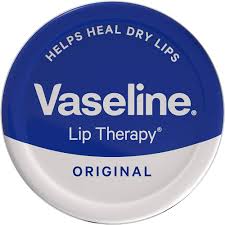 I guess we all have a jar or tin of Vaseline at home. Something we use rarely, mostly for sore lips in winter. I guess we all have a jar or tin of Vaseline at home. Something we use rarely, mostly for sore lips in winter.
It’s a lubricant, petroleum jelly, in fact - keep your dirty thoughts to yourselves, BTW!
But there are other uses (apart from in the bedroom).
Take a look at these ideas:
1. Unstick a Stubborn Lock
Got a key that won't turn smoothly in a lock? A dab of Vaseline can make keys glide into locks dead easy. It's a simple fix for an annoying problem!
2. Shine Up Leather Goods
Give your leather bags and belts a new lease of life with a touch of Vaseline. It helps keep the leather soft and adds a subtle sheen, making your accessories look brand new!
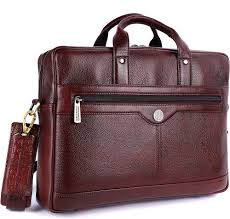
Photo courtesy of Amazon
3. Squeak-No-More
Those annoying squeaky hinges on doors or cabinets? A bit of Vaseline can quiet them down instantly. It’s a handy and quick lubricant that you probably didn't think of using this way! Better than messy oil.
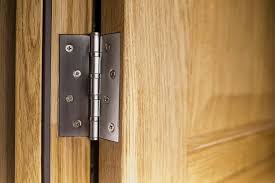
Photo courtesy of UAP Corporate
Vaseline works magically on squeaky hinges!
4. Prevent Battery Corrosion
A thin layer of Vaseline on your car battery terminals can help prevent corrosion. Extend the life of your battery with this simple trick - who knew car maintenance could involve Vaseline?
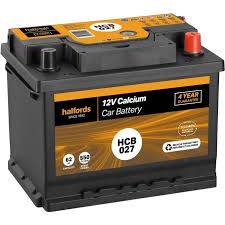
Photo courtesy of Halfords
5. Ease Sticky Drawers and Windows
Stuck window or drawer? Apply a little Vaseline to the tracks or sides, and they'll slide open and closed effortlessly. It’s a fantastic solution for those frustrating jams!
6. DIY Candle Holder Cleaner
Remove leftover wax easily from candle holders by first coating the inside with Vaseline. After the candle burns down, the wax slides right out. It’s a neat trick for candle lovers!
7. Preserve Outdoor Lightbulbs
Lightbulbs in outdoor fixtures can get corroded and hard to remove. A thin Vaseline coat before screwing them in can prevent this. Practical and smart, right?
8. Keep Your Pumpkin Fresh
After carving your Halloween pumpkin, smear Vaseline on the cut edges. This trick keeps your spooky creation from drying out and wilting too soon!

Photo courtesy of Freepik
9. Protect Outdoor Tools
Coat your garden tools with Vaseline before storing them. It helps prevent rust and keeps them in tip-top shape for gardening season.
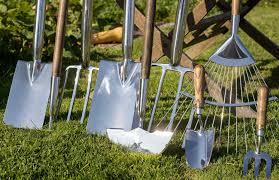
Photo courtesy of Haxnicks
10. Protect your Pet's Paws
In winter, protect your pet's paws from salt and snow by rubbing a bit of Vaseline on their pads before walks. It’s a pet-friendly use that’s both caring and effective!

Photo courtesy of Healthy Pet
Conclusion
Try these ideas out and experience the magic of Vaseline in your daily life.
Who’d a thought it!
© The Crazy Guy
Acknowledgements:
Freepik
Halfords
Haxnicks
Healthy Pet
Simplify
UAP Corporate
Wikipedia
Tags:
battery corrosion, battery terminals, belts, Candle Holder, candle wax, car maintenance, Crazy Guy, Freepik, garden tools, Halfords, Halloween pumpkin, Haxnicks, Healthy Pet, hinges, leather bag, lubricant, Outdoor Lightbulbs, Outdoor Tools, petroleum jelly, pet's paws, Simplify, sore lips, Sticky Drawers, Sticky Windows, UAP Corporate, Vaseline, wax, Wikipedia
 0
Like
Published at 8:00 PM Comments (0)
0
Like
Published at 8:00 PM Comments (0)
HOW TO ..... renovate GARDEN FURNITURE?
Monday, March 25, 2024
When The Crazy Guy moved in to his new home near Ronda in 2011, he shipped over a container full of his furniture, garden equipment, tools and other stuff from the UK.
 Included was a wooden "lovers' seat" for the garden. It's been well used in the intervening 13 years, but has suffered from the weather: extreme sunshine, freezing temperatures and pouring rain from time to time. Included was a wooden "lovers' seat" for the garden. It's been well used in the intervening 13 years, but has suffered from the weather: extreme sunshine, freezing temperatures and pouring rain from time to time.
Rather than dump this seat, he decided to revive his woodworking skills from school 60 years ago!
How did he get on?
To dump or renovate?
Given the cost of garden furniture these days, whether wooden, metal or plastic, I decided to have a go at renovating this item.
First of all I cannibalised some other garden furniture in worse condition and harvested wood recycled from pallets.
Secondly, I cut out or removed the rotten timber.
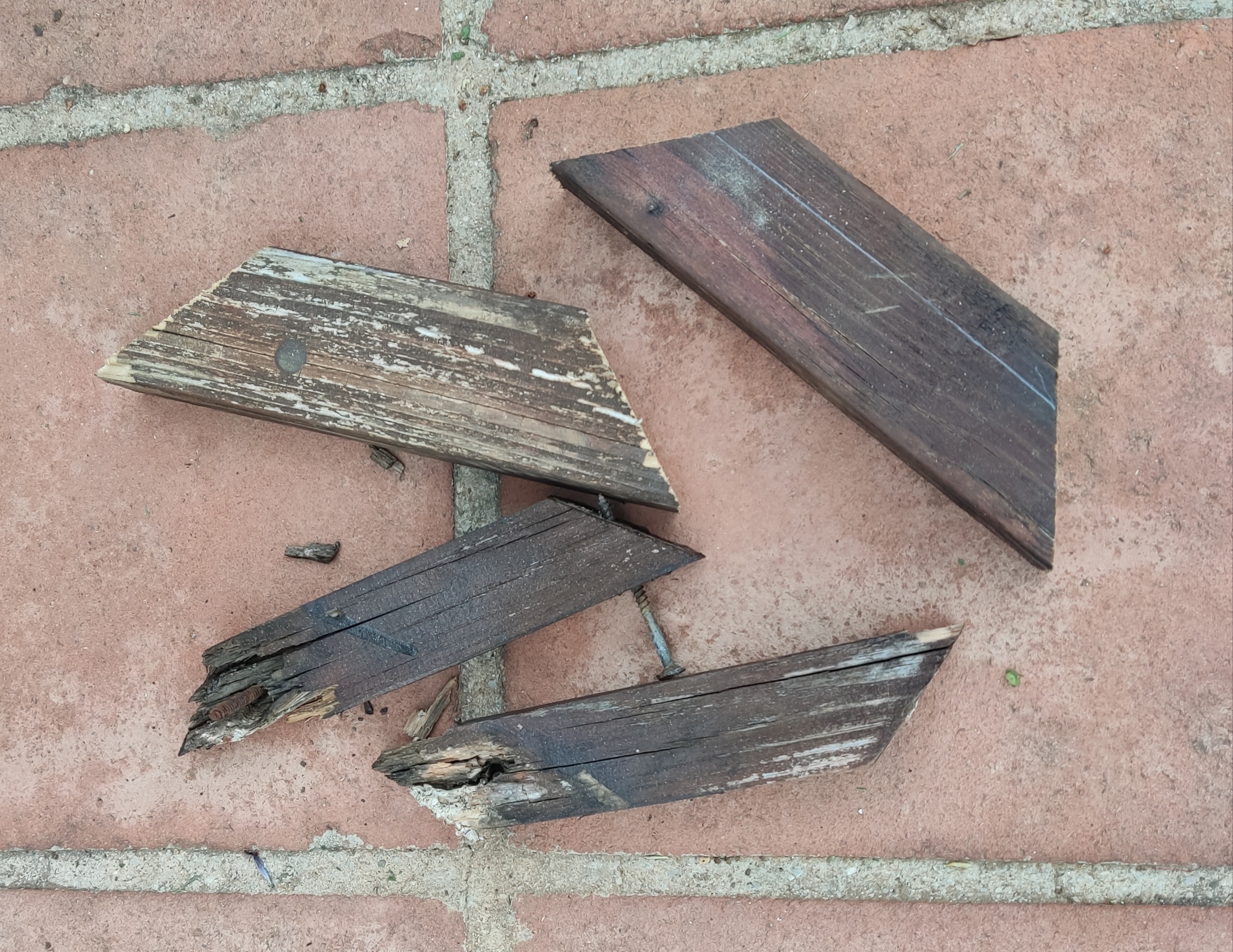 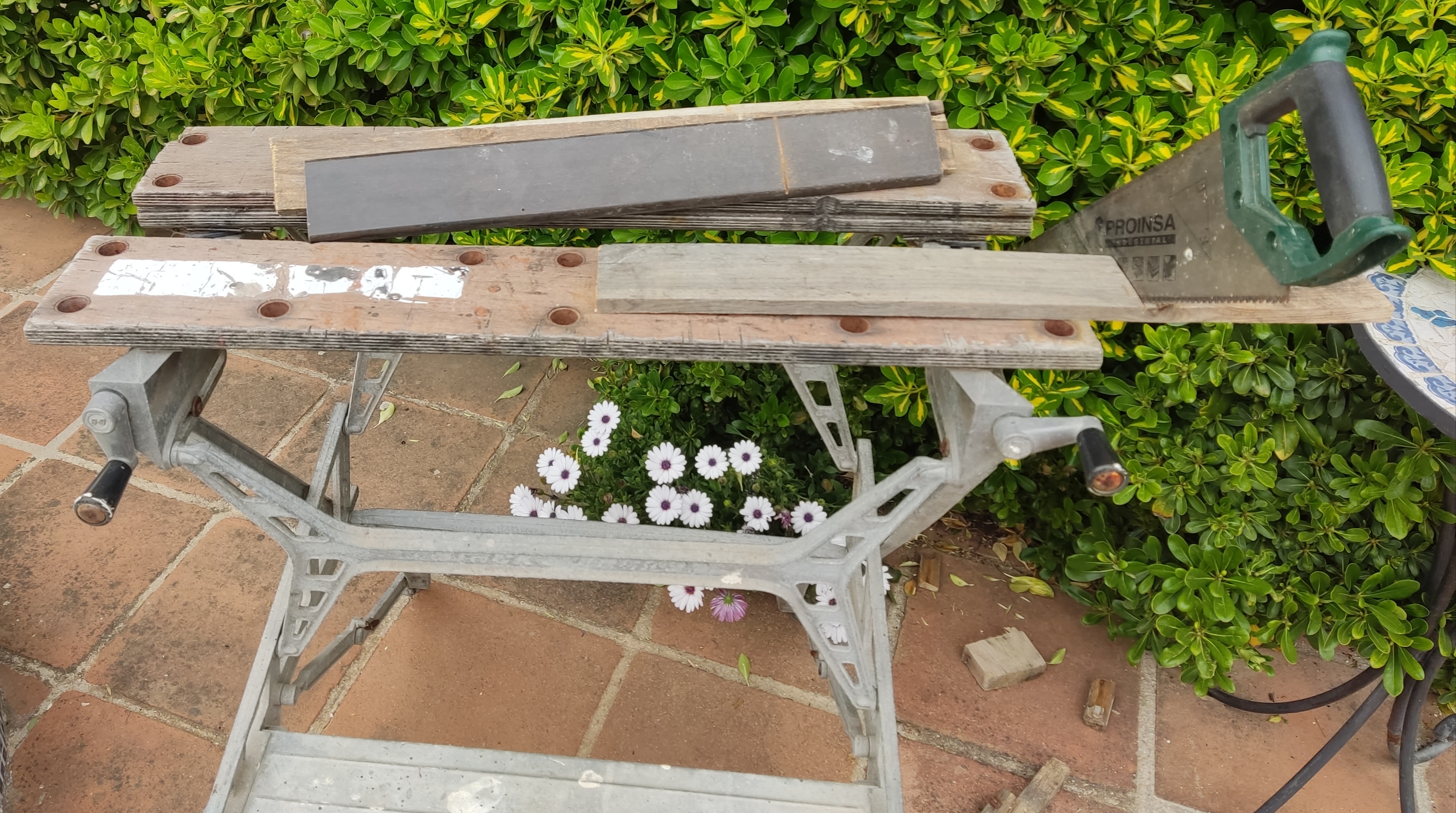
Next I selected decent recycled wood and cut it to size.
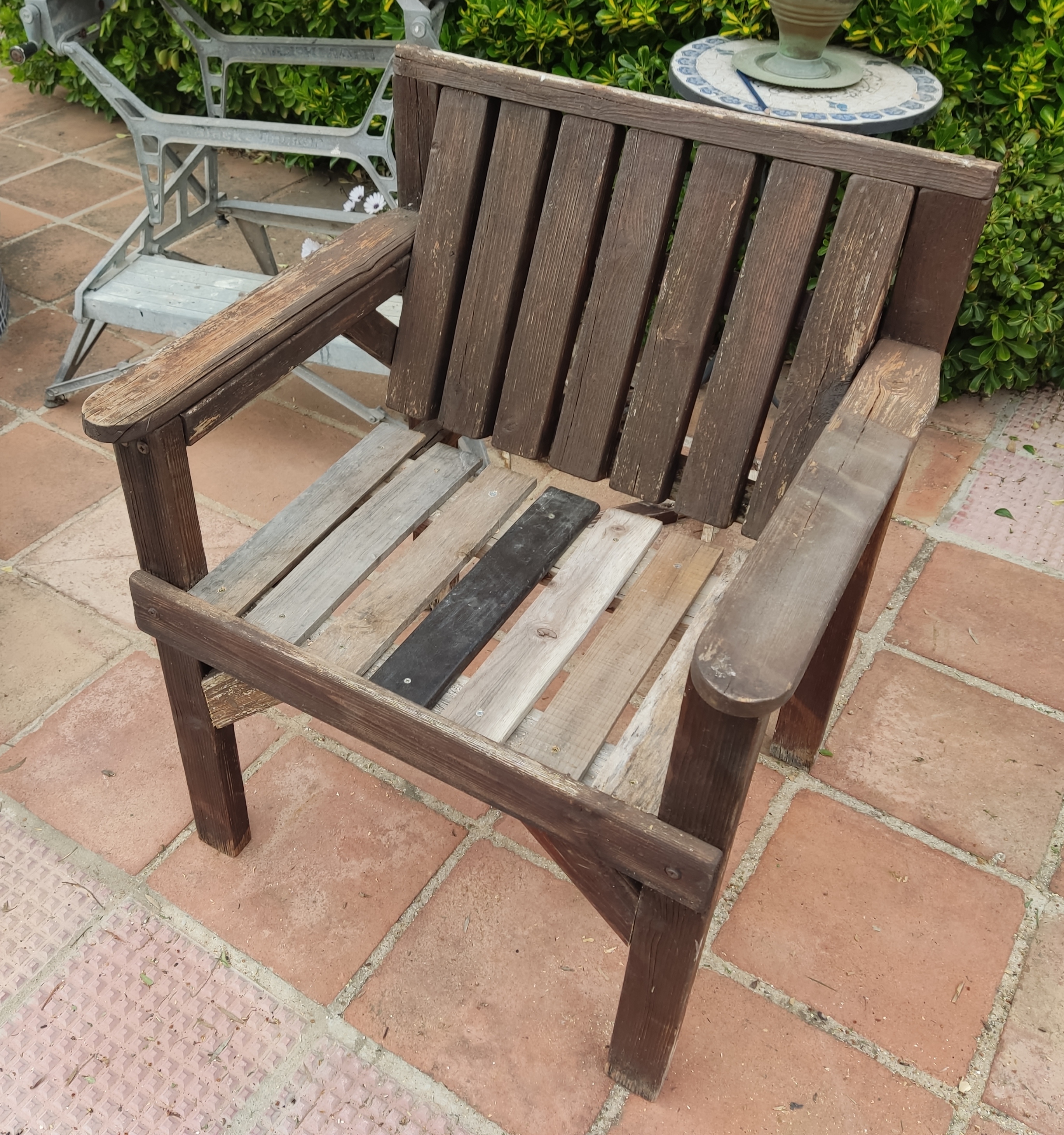 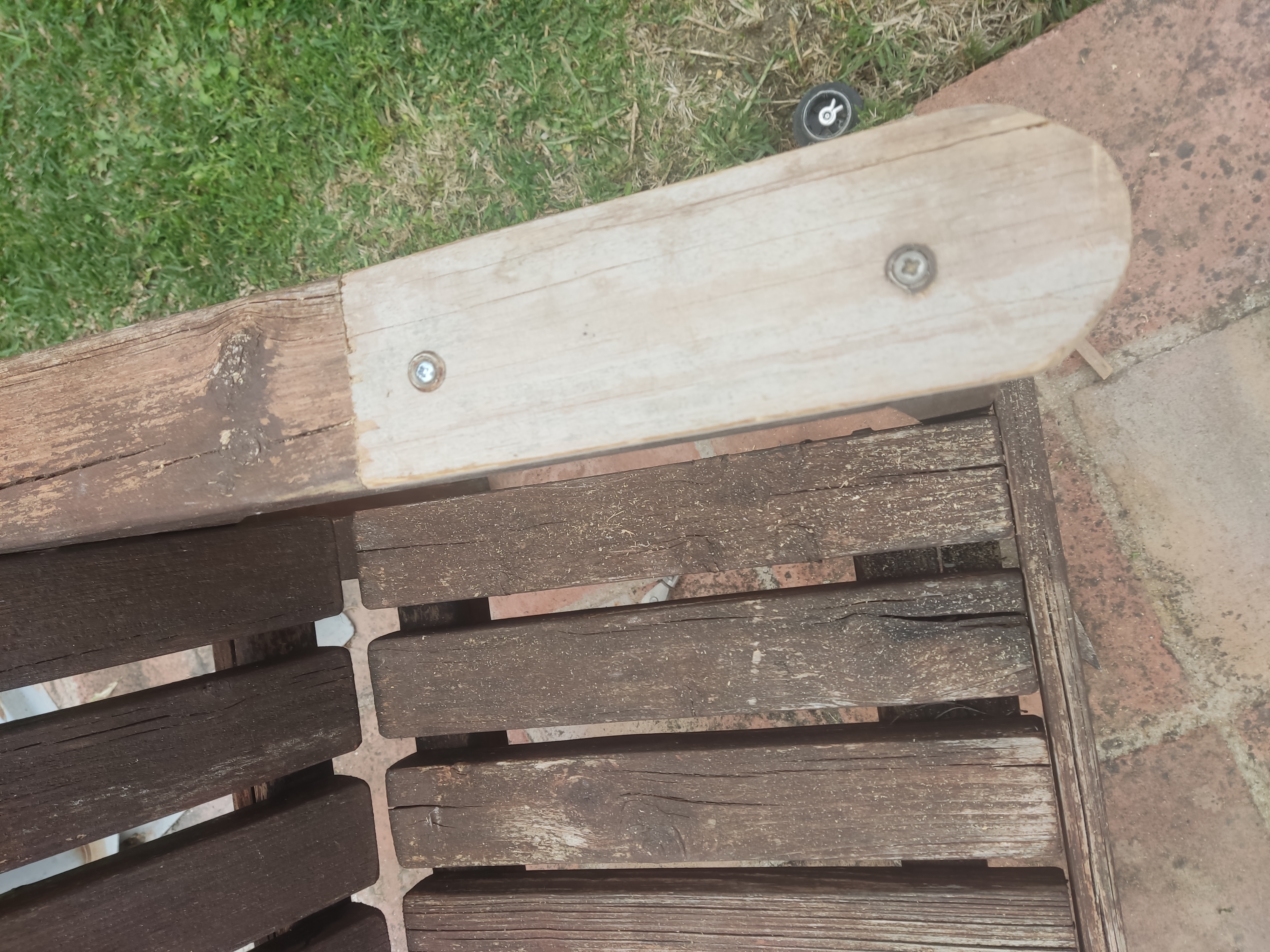
Then I screwed the new timber in place.
Finishing the job
A quick rub down and I applied two coats of preservative paint.
 
The cost?
I already had the paint, the recycled wood was free and my time, around two hours, was also not charged.
Not bad eh?
© The Crazy Guy
Tags:
cannibalised, container, Crazy Guy, dump, extreme sunshine, freezing temperatures, furniture, garden equipment, garden furniture, lovers' seat, pallet, pouring rain, preservative paint, recycled, renovate, Ronda, rotten, timber, tools, wood, woodworking skills
 1
Like
Published at 10:17 AM Comments (0)
1
Like
Published at 10:17 AM Comments (0)
HOW TO ..... build a LOG STORE?
Thursday, February 1, 2024
By The Crazy Guy
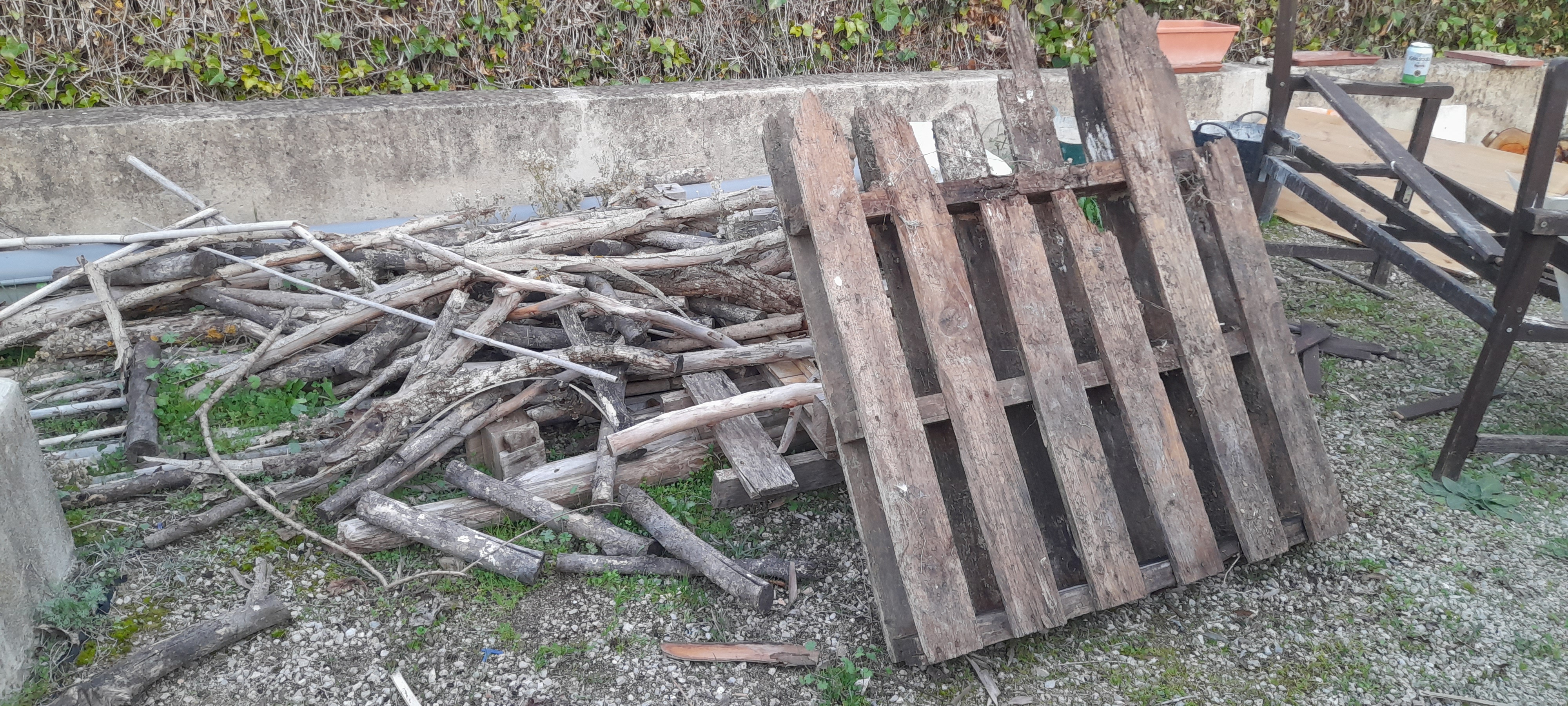 I've got loads of wood lying around at the back of my garden. Old tree branches, pallets, an old wooden banister. You name it, I've got it, cluttering up a corner of the garden. I've got loads of wood lying around at the back of my garden. Old tree branches, pallets, an old wooden banister. You name it, I've got it, cluttering up a corner of the garden.
Recently, after a storm, three eucalyptus trees from my neighbour's garden fell onto my land. So I've got that wood too. The people who mended my broken fencing also kindly sawed the wood up into "bite-size" logs for burning in two or three years time, when the wood has fully dried out.
But what to do with it all? I decided I needed a log store.
So, over the last couple of weeks, dodging the rain and after suffering a heavy cold, it's just about finished. The best bit is, I built it with materials I already had. All I needed to buy was a plastic downspout, which cost me 6€.
Siting the store
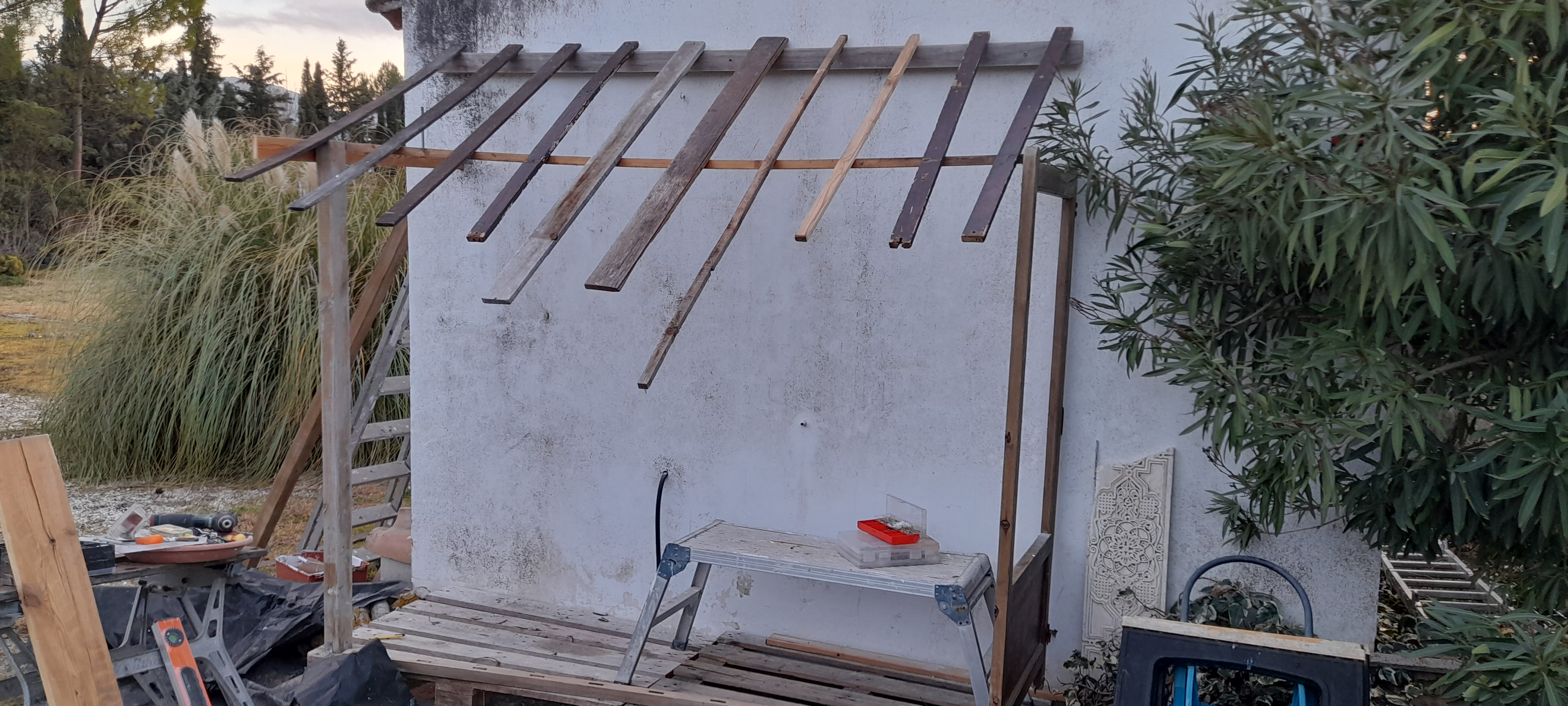 Preferably out of sight and against a wall, in other words a lean-to. There was only one place, really, against the back wall of the pumphouse (our water source is a well sunk into the aquifer deep below the ground). Preferably out of sight and against a wall, in other words a lean-to. There was only one place, really, against the back wall of the pumphouse (our water source is a well sunk into the aquifer deep below the ground).
I had a lot of timber left over from my house renovation in Montejaque (Malaga), and enough roof tiles to make it look in keeping with the rooves of other buildings around here.
Getting started
First job was to select a couple of decent pallets to sit the logs on. These would ensure good air circulation and provide a firm base for the structure.
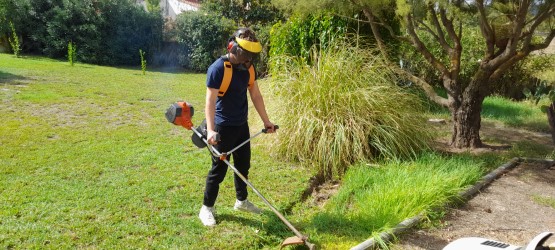 Next was to build the frame. This was a two-man job, so I called on Ollie, the 19-year-old son of friends Nick and Julia. Ollie is saving for a four month tour of the Far East before heading off to university in September 2024. In Exeter (Devon), coincidentally, where I lived as a teenager. He was already working for me that day, strimming and clearing up in the garden. Next was to build the frame. This was a two-man job, so I called on Ollie, the 19-year-old son of friends Nick and Julia. Ollie is saving for a four month tour of the Far East before heading off to university in September 2024. In Exeter (Devon), coincidentally, where I lived as a teenager. He was already working for me that day, strimming and clearing up in the garden.
Dodging the rain
I had to stop work for a few days because it rained heavily. Then I caught a stinker of a cold, which caused me to down tools for a couple of days.
But in the past week I've worked on the almacen for several hours each day.
Having got the main structure in place I then used a roll of left-over plastic membrane for the roof, before laying the tiles on top.
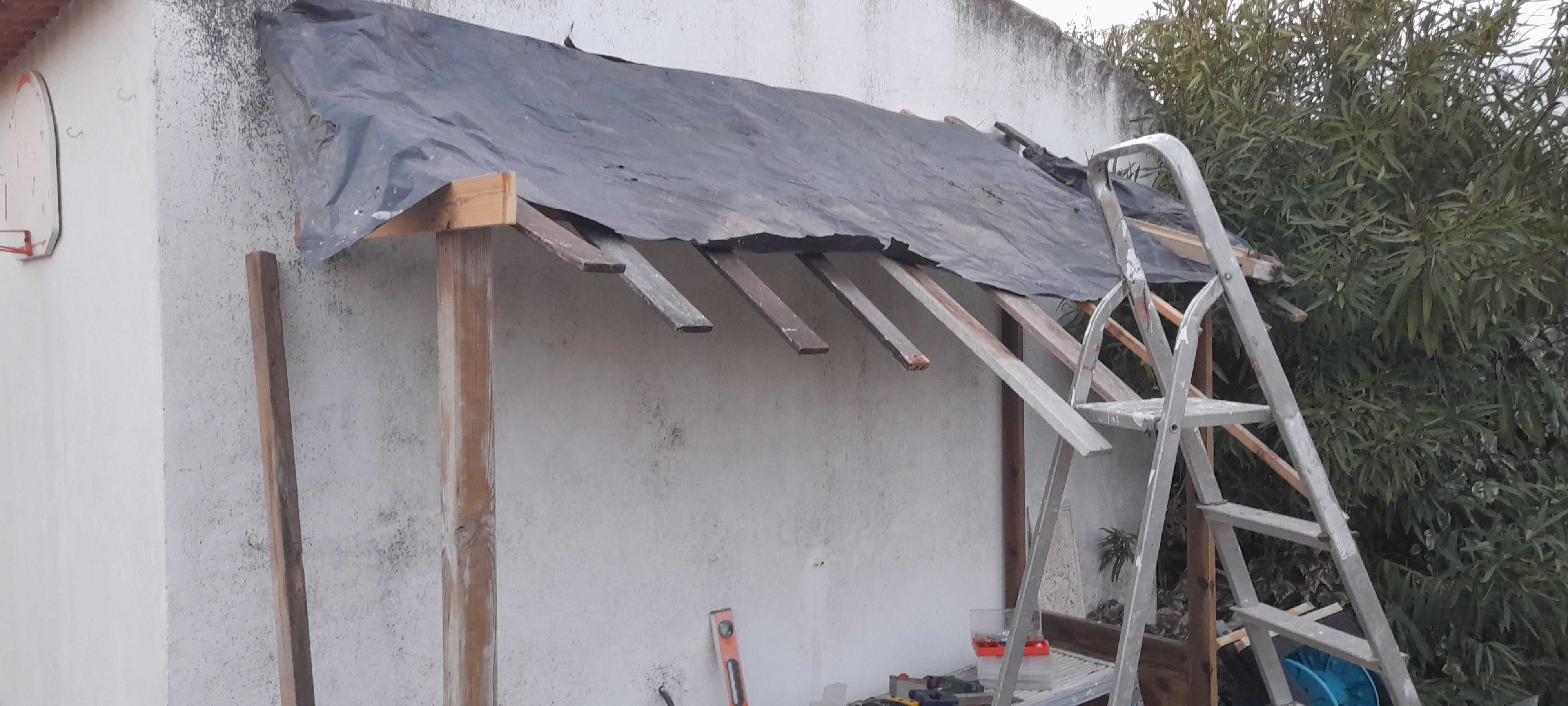 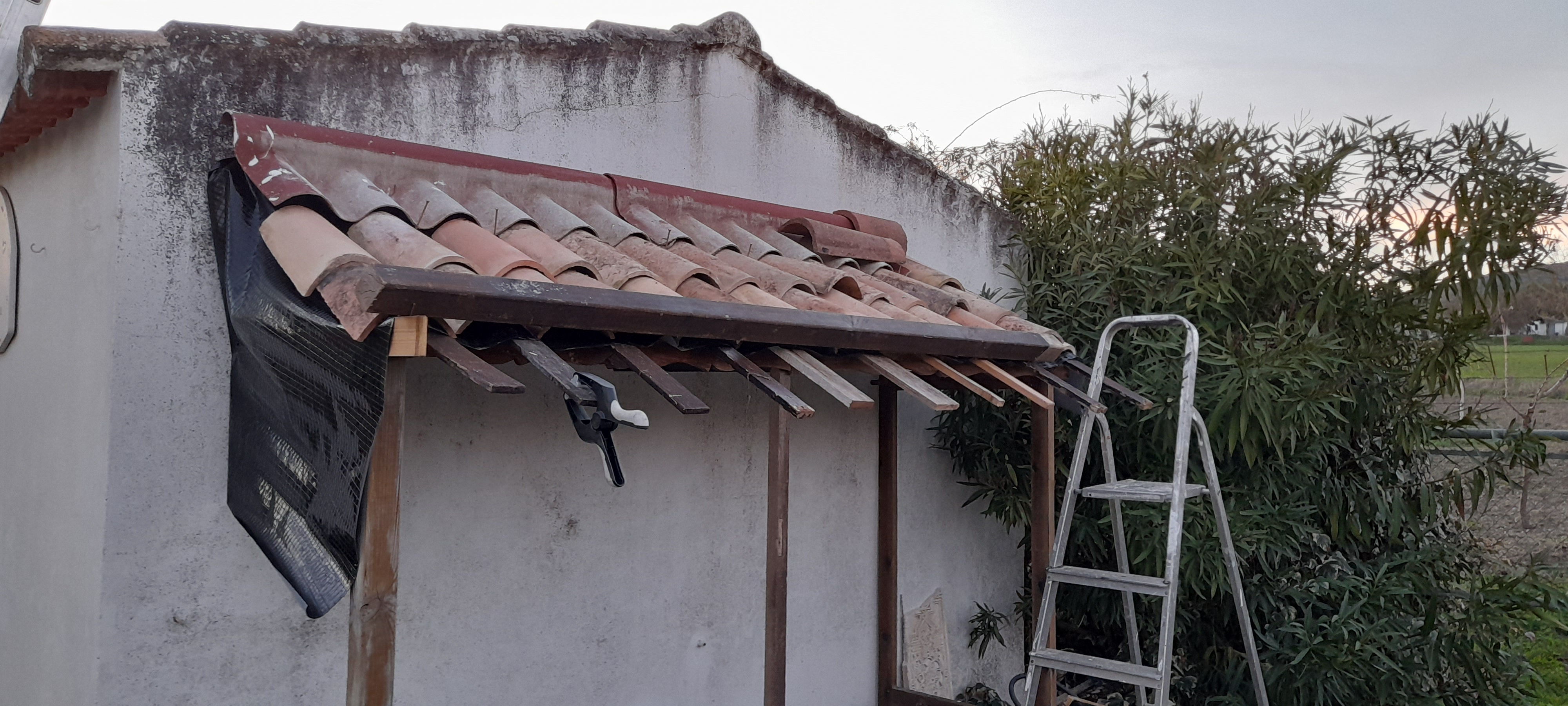
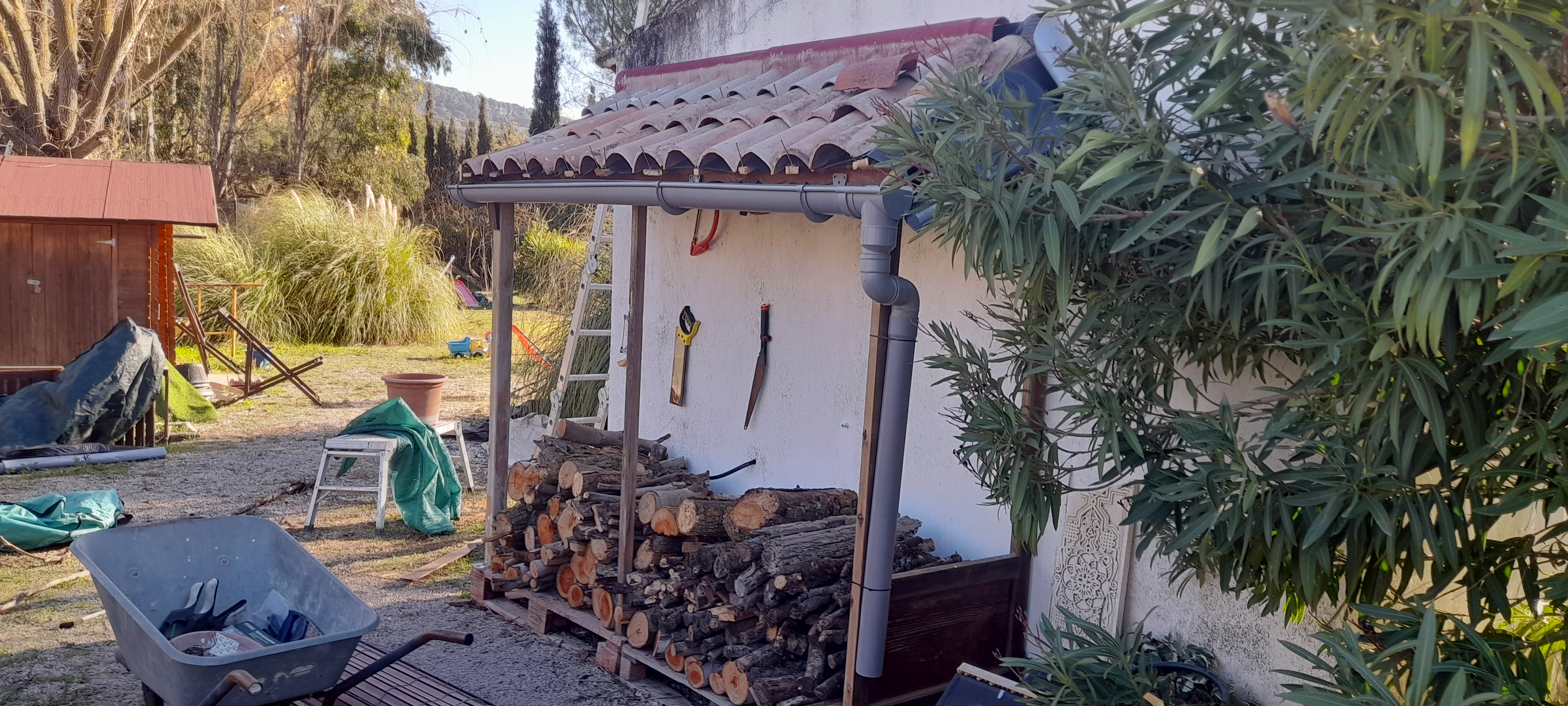
Filling the store
 I then set to, cutting the wood into useable sizes. I had a mixture; sticks/twigs for kindling, bits of old pallet, which burn easily, and large logs which burn slowly and give off loads of heat. I then set to, cutting the wood into useable sizes. I had a mixture; sticks/twigs for kindling, bits of old pallet, which burn easily, and large logs which burn slowly and give off loads of heat.
Job done
In the future I might add some side "walls" and also use a recycled persiana at the front, but that's not urgent.
© The Crazy Guy
Note: All photographs by the author
Further reading:
Casa Real: A building project in Montejaque - Part I (secretserrania.com)
Casa Real: A building project in Montejaque – Part II (secretserrania.com)
Casa Real: A building project in Montejaque – Part III (secretserrania.com)
The Building History of a 72-year-old DIY Fan (eyeonspain.com)
The Houses That Jack Built - update (eyeonspain.com)
The story of El Rincón in Ronda - the “City of Dreams” (secretserrania.com)
Tags: almacen, banister, building project, Casa Real, Casa Rita, Crazy Guy, Devon, DIY, downspout, El Loco, eucalyptus, Exeter, eye on spain, log, log store, Montejaque, Oliver, Ollie, pallet, persiana, Rincon, Ronda, secretserrania, the houses that Jack built, Villa Indiana, wood
 1
Like
Published at 9:22 AM Comments (1)
1
Like
Published at 9:22 AM Comments (1)
HOW TO ..... get your HOLIDAY RENTAL PROPERTY in Andalucía legal
Thursday, June 29, 2023
 Regulations surrounding holiday rental accommodation in Spain have been tightened up in recent years. It was previously unregulated and many owners "forgot" to declare their rental income to the taxman. Regulations surrounding holiday rental accommodation in Spain have been tightened up in recent years. It was previously unregulated and many owners "forgot" to declare their rental income to the taxman.
Nowadays, rental properties have to conform to certain standards and rental booking sites are obliged to inform Hacienda of all bookings made through them.
In Andalucia a rental property must be registered with the police. In urban areas with the Policia Nacional and in rural areas with the Guardia Civil. Each property is assigned a unique registration number, which must be displayed on a sign affixed to the exterior of the property and included in advertising and other paperwork.
What constitutes ‘Holiday Rental Accommodation’?
 Holiday rental accommodation is the term used for properties located in a residential area that are offered for short-term paid-for rentals. In other words, accommodation which is promoted or marketed via tourism channels. Holiday rental accommodation is the term used for properties located in a residential area that are offered for short-term paid-for rentals. In other words, accommodation which is promoted or marketed via tourism channels.
A tourism channel is considered to be a travel agency, an intermediary company or website that provide tourist services and/or a booking facility.
There are some exclusions from the new regulations:
• Homes that have guests where no financial transaction has taken place.
• Dwellings contracted for more than two months continuously by the same tenant (long-term holiday rentals).
• Homes that are located in rural areas
• A group of properties consisting of three or more dwellings with the same owner, which are located in the same building or in neighbouring urbanisations or buildings within a 1km radius, (these are classified as Touristic Apartments and will be subject to other legislation.)
What types of properties can be rented for tourism purposes?
• A property in its entirety. The maximum capacity will be limited by the license of occupation, but may not exceed 15 people, with a maximum capacity of 4 people per room.
• A room only. The owner must also reside in the property. You can use an internationally recognised name (eg. bed & breakfast). The maximum capacity will be 6 people with a maximum of 4 people per room.
What are the necessary requirements?
• An occupational license that shows your property complies with technical conditions and quality requirements for housing.
• The property must have direct external ventilation or via a patio and having a window shading system either by blinds or curtains.
• There should be sufficient equipment and furniture for immediate use.
• Air conditioning units must be fitted in all bedrooms and lounge areas that provide cooling (if rented from May to September) and heating (if rented from October to April). Properties are exempt when the building is classified as “of Cultural Interest” and where modifications and/or building work is prohibited.
• There must be a fully stocked medical kit.
• There should be access to information about local amenities, i.e. shops, restaurants, nearby parking, medical services, public transport, etc.
• There should be a Complaints book available to guests.
• The property should be freshly cleaned prior to the arrival and after the departure of clients.
• The property should be supplied with adequate bedding, towels and household goods in general, as well as spare sets.
• A contact number must be provided for answering questions or responding to issues regarding the property.
• Adequate information and instructions for electrical appliances should be available to guests.
• Guests must be informed of the property rules in relation to the use of facilities, pets or smoking restrictions.
How to register a home in the Registry of Tourism of Andalusia
 • The homeowner must submit a statement to the Ministry responsible for tourism, confirming the property is in accordance with all the requirements of the law. Once submitted, the property can be rented out with immediate effect. The minimum content of the statement of responsibility will include: • The homeowner must submit a statement to the Ministry responsible for tourism, confirming the property is in accordance with all the requirements of the law. Once submitted, the property can be rented out with immediate effect. The minimum content of the statement of responsibility will include:
1. Property details including cadastral reference and the maximum capacity as stated by the license of occupation;
2. Information about the property owner, whether an individual or a company, including contact address for notifications.
• The registration number of the property assigned by the Registry of Tourism of Andalusia must be indicated in all promotional materials or advertising of the property.
• The Registry of Tourism of Andalusia must be notified of any changes in circumstances such as changing to long term rentals.
Deadlines
The Decree was published on 11th February 2016. Registration opened 3 months after this date, which made12th May 2016 the deadline for registering a property in the Registry of Tourism of Andalusia.
Homeowners have one year to comply with the requirements of fixed air conditioning and heating units as required in the property.
Who is legally accountable to the administration and tourists?
The homeowner is considered to be legally accountable to the administration and holidaymakers, unless otherwise stated.
How are tourist rentals processed and reservations taken?
• All holidaymakers must receive a document, by way of contract, which specifies the homeowner, the registration number with the Registry of Tourism, the holidaymaker’s details, the start and end dates of their stay, the total price of the stay, and contact number.
• All holidaymakers must present their identification document so that the homeowner can register their data according to the norms of registry of travellers in hotels and other types of accommodation.
• The arrival and departure times will be by mutual agreement between the homeowner and the client. Unless otherwise stated, the arrival time will be at 16:00 and departure time at 12:00.
• Upon arrival, the homeowner must provide keys and/or access cards to the entire compound, as well as information about the use of appliances and, if applicable, the rules of the community.
• The advertised price has to be by night and must include the costs of the use of water, electricity, gas, cleaning and bedding.
• The terms of price, reservation and payment shall be established between the two parties. However, they must be stated in detail before the booking is confirmed. Proof of advance payments must be provided, if applicable.
• The homeowner may request an advance payment as a deposit up to a maximum of 30% of the total price unless previously agreed otherwise.
• If the client cancels the reservation up to 10 days beforehand, the homeowner may keep up to 50% of the deposit. If the cancellation is made with less than 10 days to spare, they may keep the entire advance payment.
• If the homeowner cancels the reservation up to 10 days beforehand, s/he must return the entire advance payment to the renter. If the cancellation is made less than 10 days beforehand, they must compensate the renter with 30% of the price of the contracted stay.
• If the rental is cancelled by either party for substantiated reason or force majeure, no compensation will be due.
Penalties
All properties that are not registered or have not filed a declaration of responsibility and are being rented out for tourism purposes could be fined up to 180,000 euros. Also, any property that does not meet the requirements of this decree may also be fined.
© Paul Whitelock
Further reading:
How to obtain a tourist rental propery licence in Andalucía (secretserrania.com)
Acknowledgements:
Fuster & Associates
Gestoria Jimenez, Ronda
Junta de Andalucia
Ministerio de Turismo
 0
Like
Published at 4:24 AM Comments (1)
0
Like
Published at 4:24 AM Comments (1)
HOW TO ….. do your Spanish INCOME TAX return?
Sunday, April 16, 2023
It’s time to think about doing your income tax return, the IRPF (Impuesto sobre Renta de Personas Físicas). You can do it yourself online, but The Crazy Guy much prefers to use a gestor. For a token charge, say 50€, a qualified gestor will do it with you in 20-30 minutes. Here’s more from The Crazy Guy.
By going to a gestoría you can save yourself a lot of worry and stress. My wife and I go to an excellent family gestoría in Ronda, where Daniel is the tax expert.
 My wife typically ends up paying a few cents tax a year, plus Daniel’s fee. I pay nothing at all to Hacienda, because my income is below the tax threshold (my UK pension is taxed in the UK, so I don’t have to pay again in Spain, under the Spain/UK dual taxation agreement. Oddly, my wife, a German, pays tax on her German pensions in Germany, but is also required to pay tax on earned income in Spain – Spain and Germany have no dual tax agreement). My wife typically ends up paying a few cents tax a year, plus Daniel’s fee. I pay nothing at all to Hacienda, because my income is below the tax threshold (my UK pension is taxed in the UK, so I don’t have to pay again in Spain, under the Spain/UK dual taxation agreement. Oddly, my wife, a German, pays tax on her German pensions in Germany, but is also required to pay tax on earned income in Spain – Spain and Germany have no dual tax agreement).
Daniel is also excellent when it comes to other tax matters. For example, when I sold a Spanish property four years ago I made a capital gain of 15,000€, and assumed I was going to get clobbered for tax. However, I sat with my Daniel, and by the time we’d deducted all the allowable off-sets, I ended up paying ….. 50€! Yes, 50€ tax, plus his fee of 50€. What a great outcome!
The Declaración de la Renta season has started and concludes on the last working day in June.
 Basically, if you are tax resident in Spain, ie you reside here for more than 183 days per year, you are required to make an annual personal declaration of your worldwide income. Basically, if you are tax resident in Spain, ie you reside here for more than 183 days per year, you are required to make an annual personal declaration of your worldwide income.
This can, of course, be either a source of dread or excitement, depending upon your situation.
If you've overpaid in the calendar year of 2022, you'll be due something back, but if you've underpaid, you'll need to hand over the difference.
If you are due a tax refund the State tax office, Agencia Tributaria or Hacienda, has until December 31 to pay it to you. If they pay after that date they must also add interest.
But the good news is that Hacienda does not normally stretch it out that long, especially if you get your declaration in early – sometimes, taxpayers get their rebates before May is out.
For those who need to pay to make up a shortfall, you would typically be expected to settle it in a lump sum before the end of June, but as long as you apply to do so before the close of the 'declaration window', you can arrange to stagger it in several payments.
Who is required to make a Declaración de la Renta?
Annual income tax declarations, in Spain, are not just for the self-employed. Almost everyone has to file one, even if they are retired or their income is from non-work-related activities – but there are some exceptions.
In general, if your income for the whole of the previous calendar year was from just one source, and was less than €22,000 in total, you are not required to make an annual declaration.
I was in this situation for years, as my only source of taxable income was the UK state pension which is way below the threshold. Now, I have one or two other sources, eg holiday rental income, income on bonds and bank savings account interest (my personal pension income, as described above, is already taxed PAYE in the UK and the net amount doesn’t count as income), so I must make a declaration. But as my total income from all sources comes nowhere near the threshold, I pay no tax anyway. All a bit futile, really. I just pay Daniel, my gestor, his 50€ fee. The whole thing is simple and free of pain.
What is classed as income?
Small amounts of money received as gifts or, for example, interest on a deposit account, selling a few second-hand personal effects at a car boot sale or on eBay or Wallapop, or a friend giving you €10 as a thanks for feeding their pets when they were on holiday, do not normally count as 'earnings' for tax declaration purposes.
However, if you are not sure whether you are exempt from making a declaration, check with your gestor, because if it turns out you should have made a declaration and you failed to do so, you could be fined.
There are other taxes, of course, that affect residents as well as non-residents, but I shall deal with those in another article.
In the meantime, further reading of possible interest is:
HOW TO ..... pay less tax in Spain? (eyeonspain.com)
HOW TO ….. Dodge the Tax Man (or not): Catastral Values and Tax in Spain (eyeonspain.com)
The taxmen are after you! - Secret Serrania de Ronda
Foreigners who pay tax in Spain stand to cash in from next year (eyeonspain.com)
 4
Like
Published at 3:54 PM Comments (12)
4
Like
Published at 3:54 PM Comments (12)
HOW TO ….. get an ECO-STICKER for your car?
Monday, January 16, 2023
By The Crazy Guy
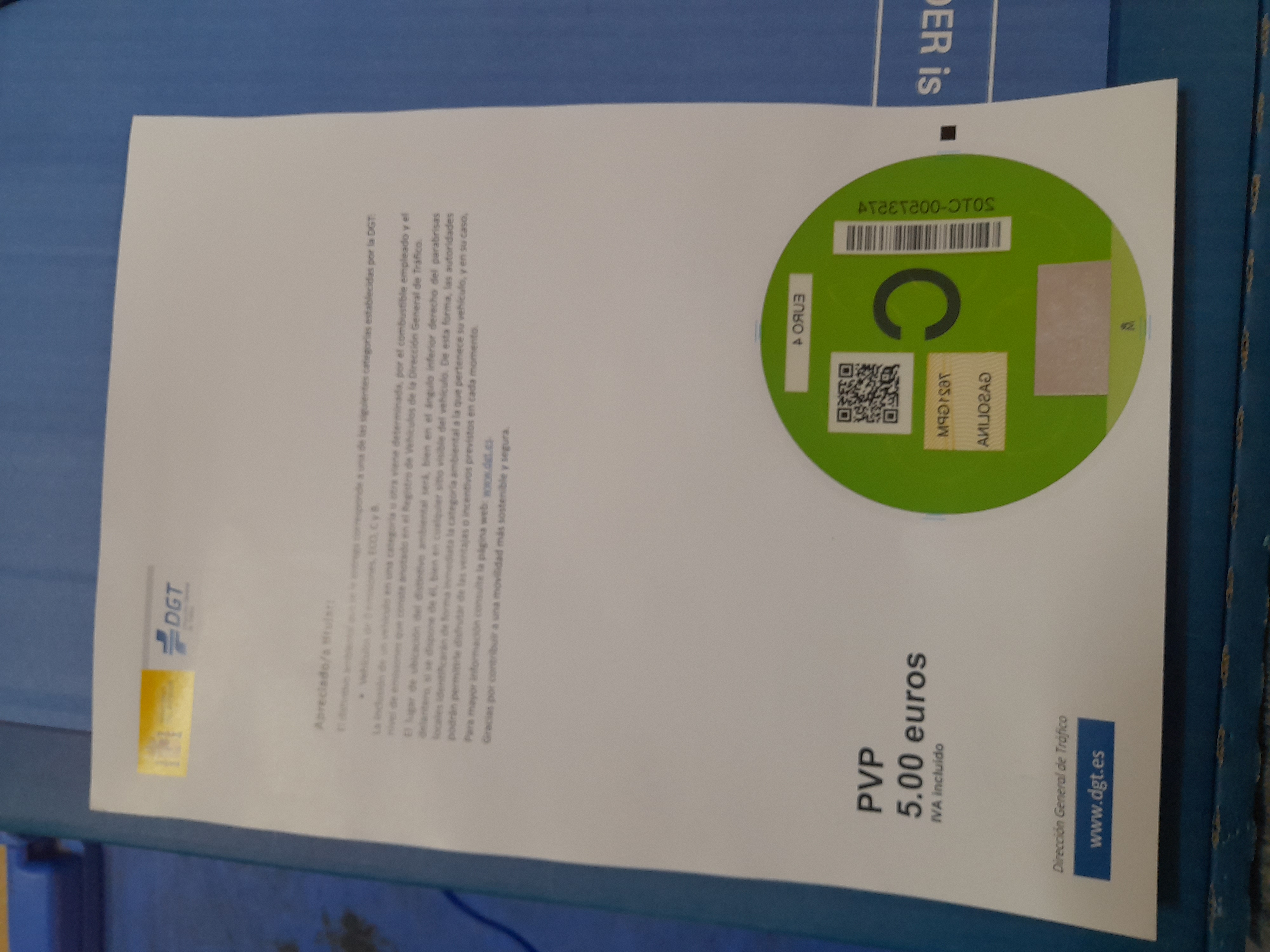
From 1 January 2023 if you want to travel into a town or city in Spain, you are supposed to display an eco-Sticker in the windscreen of your car. From the end of the year all towns in Spain with more than 50,000 inhabitants must have the infrastructure in place to monitor cars entering their municipio. From that date it is also compulsory for drivers to display the appropriate sticker for their vehicle.
Older vehicles are not eligible and must not enter these urban ZBEs (Zonas Bajas Emisiones – in English Low Emissions Zones). But you may still drive your car outside of these areas.
These restrictions do not apply to foreign-registered vehicles.
Background
This initiative, which has already begun in cities such as Madrid, Barcelona, Valencia and Sevilla, as well as Valladolid, Alicante and Murcia, is designed to clean up the polluted air in inner-city areas.
All of a sudden, car owners are getting concerned. I first heard about it when a friend posted a link to a WhatsApp group before Christmas.
Since then The Olive Press has published an article (current edition Issue 410 or www.theolivepress.es).
Lenox a blogger at EyeOnSpain has also covered it in a very witty article. See below.
The Stickers
There are five categories and four stickers. Category A is for vehicles which are too old and have high exhaust emissions and MAY NOT ENTER A ZBE. Petrol vehicles registered before 2001 and diesels before 2006 fall into this category.
The other categories are colour-coded:
B, yellow, is for petrol vehicles registered from 1 January 2001 and diesels from 1 January 2006.
C, green, is for petrol vehicles registered from 1 January 2006 and diesels after 1 September 2015.
Eco, green and blue, is for hybrid, natural gas, CNG or LPG vehicles
Zero ‘O’, blue, for electric, hydrogen or fuel cell vehicles.
You can find out which sticker is for you by going to the DGT website and entering your registration number. My car is relatively new, so I get a green sticker.
Please note: Foreign-registered vehicles are not required to display a sticker. But you would be advised to make sure the vehicle is legal in Spain.
How to get your sticker
There are several ways:
- Online at the DGT website (Direccion General de Tráfico)
- At any post office – Correos
- At selected car parts distributors – in Ronda at Sierra Sur Recambios Ronda in Calle Río Guadalteba in the Polígono Industrial.
A sticker costs 5€.
***
I went to Sierra Sur today to get mine. All I needed to show were the car’s documents and my ID.
Five minutes, five euros. Sorted.
With thanks to:
Jill La Peche
Jo Chipchase
Lenox Napier
The Olive Press
© The Crazy Guy
Other useful links:
Correos www.correos.es
DGT www.pegatinas-dgt.com
https://sede.dgt.gob.es/es/vehiculos/distintivo-ambiental#
EyeOnSpain Eco Stickers and How Long Have We Got? (eyeonspain.com)
N332 www.n332.es
The Olive Press Spain is introducing low emission zones in city centres that will prohibit 75% of vehicles. Does this affect your car? - Olive Press News Spain (theolivepress.es)
Upsticks https://upsticks.es/driving-in-spain-eco-stickers-all-you-need-to-know/
Tags: CNG, Correos, Crazy Guy, DGT, diesel, dirección general de tráfico, eco-sticker, fuel cell, LEZ, LPG, Olive Press, petrol, Sierra Sur Recambios, ZBE
 2
Like
Published at 1:07 PM Comments (7)
2
Like
Published at 1:07 PM Comments (7)
HOW TO ….. FLY?
Wednesday, January 11, 2023
In these difficult economic times, brought about by Covid-19, Brexit and the war in Ukraine, it’s perhaps worth taking a look again at HOW TO FLY.
The Crazy Guy is a triple-F, ie a Fairly Frequent Flyer. When he went abroad, to the UK or Germany, he would drive to the airport – Malaga, Jerez, Sevilla or Granada – and valet-park the car until he returned.
In the years BC – before car – I either used to get the bus or get picked up by friends. After that, we used to drive to the airport, and park the car until our return. Nowadays, with prices of everything rocketing – flights, fuel, car parking – I am looking at ways of flying more cheaply.
I shop around for flights being prepared to use any of the “local” airports, even Gibraltar. Being retired, I can be flexible on dates. Some days are cheaper than others, eg mid-week and on Sundays. I try to travel light, so as to avoid checked-in luggage charges. The small free carry-on bag is adequate for short visits. When my daughter comes to visit with her two young children at half-term, she intends to travel light, buy stuff here and leave it at our house for future visits.
Fuel has gone up in price and, since January and the disappearance of the Spanish government subsidy, costs 20 cents a litre more.
Car parking charges have also increased. Not really sure why, since they have no fuel costs, as they use the client’s car to get to and from the airport. Profiteering?
So, for our most recent trip, to Germany for Christmas and New Year, we decided to use public transport as far as possible.
We got the coach from Ronda to Malaga (6€* each) and stayed at a hotel near the airport (Royal Costa 40€) - our flight was very early in the morning. The local train wasn’t running at that time of the morning so we had to get a taxi to the terminal, but it only cost 15€.
Our return flight was to Sevilla, but landed too late for a bus connection to Ronda, so we stayed in a hotel (IBIS Budget 60€). The following morning we took an Uber to the bus station (10€ - 2€ more than the bus) and caught the coach to Ronda (6€* each) and a taxi home (17€).
By the way, the airport legs in Germany (Baden-Baden to Heilbronn and back) were done by public transport also, namely bus, S-Bahn and train (36€ each for the entire return journey).
It all worked perfectly fine. It was more relaxing and less exhausting than driving in the early dawn and late at night, and we saved money into the bargain.
We paid just under 230€ for both of us for everything in both Spain and Germany, except the flights. If our flight timings had been more conducive we could have skipped the taxis and the hotels and saved even more. In that scenario we would have only paid just under 80€ for both of us!
By comparison, normal taxis to and from the airport would be around 300€. Paying a friend would cost, say 180-200€, if you can find one willing to do it at that time of day. Driving and parking at the airport would come to about 110€, but that only works if you fly from and back to the same airport.
Conclusion? On this occasion, we chose the best option in terms of comfort and cost. I think we will do the same in the future.
How to fly? USE PUBLIC TRANSPORT. DEFINITELY!
* discounted price with tarjetasesentaycinco
Further information:
www.booking.com
www.damas-sa.es
www.skyscanner.com
www.uber.com
© The Crazy Guy
Tags: Baden-Baden, bus, coach, Crazy Guy, Germany, Gibraltar, Granada, Heilbronn, IBIS Budget, Jerez, Malaga, public transport, Royal Costa, S-Bahn, Sevilla, taxi, train, Uber
 1
Like
Published at 8:40 AM Comments (2)
1
Like
Published at 8:40 AM Comments (2)
“WHEN I’M 65…”: HOW TO ….. get a tarjetasesentaycinco
Sunday, December 11, 2022
The Crazy Guy
Recently in the post I received my tarjeta sesentaycinco from the Junta de Andalucía. I’d applied for it only a week or so previously. It entitles me to a range of benefits, namely
- Permanent telephone support from the Andalusian region 24 hours a day, 365 days a year
- 50% discount on interurban bus tickets
- 30 – 55% discount on spectacles, frames and varifocals
- 30-35% discount on hearing aids
- Discounts on cultural and leisure events
- Free legal consultation
- Luncheon vouchers
- Domestic grants
Applying for the card
The card is applied for online or by printing off the form here (in Spanish). There is a helpline which can be answered in English (Monday to Friday) on (0034) 900200165.
Eligibility criteria:
- over 65
- resident in Andalucía
- empadronado (on the electoral roll)
What to do:
- you apply at your local town hall.
- You have to provide a recent passport photo and copies of an identity document, residence (NIE or TIE) and padrón certificate.
- The card is free and lasts five years at which point you can renew for free.
***
I’m off now on an interurban bus to get new glasses and a hearing aid. If the bus crashes, I can ring the 24-hour helpline and get free legal advice!
© The Crazy Guy
Tags: 24-hour, card, certificate, crazy guy, discount, document, empadronado, free, grant, hearing aid, helpline, identity, interurban, junta de Andalucía, legal advice, NIE, online, padron, passport, photo, resident, sesentaycinco, spectacles, tarjeta, TIE, town hall
 1
Like
Published at 9:40 AM Comments (0)
1
Like
Published at 9:40 AM Comments (0)
HOW TO ….. SAVE MONEY
Wednesday, November 9, 2022
 In the midst of the cost-of-living crisis currently raging through Spain, Europe and the world, The Crazy Guy recommends the following 13 money-saving tips. Maybe he's not so crazy after all? In the midst of the cost-of-living crisis currently raging through Spain, Europe and the world, The Crazy Guy recommends the following 13 money-saving tips. Maybe he's not so crazy after all?
Air conditioning
Avoid using it. There are other ways to keep your house cool in the summer. Click here to find out how.
Air conditioning in your car increases fuel consumption. Open your window instead.
Airport water
Once through baggage control, most outlets at Málaga Airport charge 2.40€ for half-a-litre. At the newsagents FOYER you can get two bottles for 2.90€. All rather expensive.
TIP 1: After you have gone through passport control you only need to pay 1€. The dispensing machines are clearly marked.
After you have gone through passport control you only need to pay 1€. The dispensing machines are clearly marked.
TIP 2: If you take an empty plastic bottle through the baggage control (permitted) you can fill up for free.
Banks
 TIP: Shop around for the best deal. You should NOT be paying maintenance charges. Check this article here. TIP: Shop around for the best deal. You should NOT be paying maintenance charges. Check this article here.
After carrying out this research I switched to CaixaBank where the criteria for free banking are easier to meet. In fact, we both switched from Unicaja Banco, who had started charging, to CaixaBank and are each saving 240€ per year.
Car use
TIP 1: Use public transport instead.
TIP 2: For airport runs consider parking at the airport, which saves two legs over somebody taking you by car.
Electricity
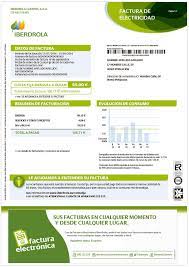 TIP 1: Shop around for a better deal, We just switched to IBERDROLA where we are guaranteed 14% saving on the bills from our previous supplier. TIP 1: Shop around for a better deal, We just switched to IBERDROLA where we are guaranteed 14% saving on the bills from our previous supplier.
TIP 2: Use the cheapest tariff, typically from 00.00 to 08.00, for certain devices, eg washing machine and tumble drier, dishwasher, ironing, pool pump and watering system.
TIP 3: Install solar panels – there is currently still a 40% discount available, but hurry!
TIP 4: Install LED bulbs.
TIP 5: Don’t leave devices like TVs, computers, charging cables, etc on standby.
TIP 6: If you have electric heating, turn it down or off and put on warmer clothes.
Firewood
TIP: Cancel your logs order. Scavenge wood from the tip, eg pallets, and saw or chop it up. Sure, it burns quickly, but at least it’s free.
Flying
TIP 1: If you can fly midweek and/or at unsocial hours, you can save a fortune.
TIP 2: Travel light, if possible with just the small carry-on bag (free). It’s surprising what you can fit into a small mochila.
TIP 3: Avoid buying food and drink on the plane. Take your own food from home or buy a meal deal at the airport (eg WH Smith). Buy 1€ water at the airport (see above) or fill up an empty bottle free-of-charge.
Fuel
TIP 1: Shop around for the best price in your area. Avoid the big chains like BP, Cepsa, Esso, Galp, Repsol and Shell. AGLA (Asociacion de Gasolineras Libres de Andalucía) are often the cheapest.
TIP 2: Consider going by public transport, eg bus or train. We recently went to Sevilla by bus and it only cost us about 26€ return for both of us (with a tarjeta sesentycinco, a discount card for over 65s). Way cheaper than fuel and parking charges.
Haircut
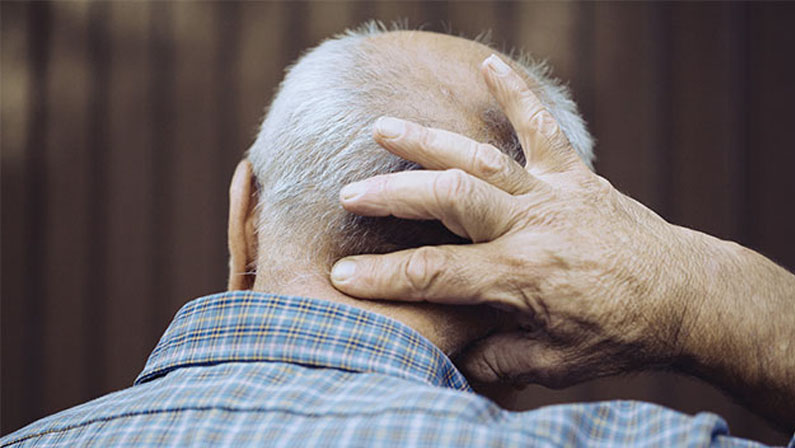 TIP 1: Go to Vicky’s, C/ Pozo, 6, 29400 Ronda (Malaga). After 6.00 pm every evening gents can get a free haircut. Your barnet will be cut by a trainee, but to save at least 10€, why not? TIP 1: Go to Vicky’s, C/ Pozo, 6, 29400 Ronda (Malaga). After 6.00 pm every evening gents can get a free haircut. Your barnet will be cut by a trainee, but to save at least 10€, why not?
TIP 2: Let your hair grow, like I am.
Hotels
TIP: Carry out your research on, say booking.com, then contact the hotel of your choice direct for an even better deal. We’ve done it twice recently in Chiclana and Sevilla and saved money.
Insurance
TIP: Shop around at renewal time. We recently saved a load on our monthly private healthcare insurance premium by switching from DKV to Sanitas.
Our current car insurer still offers us the cheapest premium, so we stayed put. CASER via Abbeygate.
Shopping
 TIP 1: Shop at ALDI, Día, LIDL and Supeco instead of at Al Campo, Carrefour, Hipercor and Mercadona. TIP 1: Shop at ALDI, Día, LIDL and Supeco instead of at Al Campo, Carrefour, Hipercor and Mercadona.
TIP 2: Buy marcas blancas (own-brand goods).
TIP 3: Shop late in the day – perishable goods are often marked down in price.
Water
TIP 1: Shower instead of having a bath.
TIP 2: Don’t leave the tap running , eg when cleaning your teeth.
***
With energy, food and transport costs soaring, not to mention services like banking and insurance, it pays to make savings where one can.
Good luck!
© The Crazy Guy
 1
Like
Published at 4:42 PM Comments (0)
1
Like
Published at 4:42 PM Comments (0)
HOW TO …..apply for a replacement TIE
Thursday, June 9, 2022
You’ve lost your wallet or had it stolen. That means you’ve probably got to apply for new bank cards, ID, TIE, driving licence, health cards, discount and loyalty cards, senior citizens card, and many more.
Most are straightforward, but the most tricky to replace are your TIE, your driving licence and your passport, if that’s gone too.
I recently lost my wallet in Germany. I expected it to show up in a bin somewhere minus the cash, but three weeks on there’s no sign of it.
I was able to cancel bank and health cards and order new ones easily either online or by calling the dedicated phone line.
I discovered that some entities no longer issue plastic cards, eg Amigos de Paradores, Leroy Merlin and IKEA Family; it’s all done digitally/virtually.
Most replacements are free. Up to now the only entities to charge a fee have been Banco Sabadell (4€), Costa Press Club (15€), TIE (12€). I expect to have to pay a fee to the DGT for a replacement driving licence, but I don’t know how much yet.
***
This week, now back home in Spain, I’ve spent hours on getting a replacement Tarjeta de Identidad de Extranjero (TIE).
Now I know how to go about it. Here’s how:
- First step is to make a denuncia to report the loss. You do this at the Comisaría de la Policía Nacional if you live in a town or city; at the Guardia Civil if you live in a village.
- Get a cita previa at your local Extranjería, which is usually in the Comisaría de la Policía Nacional. Do this online at https://sede.administracionespublicas.gob.es/pagina/index/directorio/icpplus
- Go to https://www.immigrationspain.es/en/duplicate-nie-if-lost-or-stolen/#3_Request_a_duplicate_at_your_closes_immigration_office, and fill in form EX-17 and print it off.
- Go to https://www.immigrationspain.es/en/duplicate-nie-if-lost-or-stolen/#3_Request_a_duplicate_at_your_closes_immigration_office, and complete modelo 790 and print it off.
- Go to any bank with the denuncia report and modelo 790 and pay the fee of 12 euros.
- Take the following to your appointment with Extranjería:
- Form EX-17
- Modelo 790
- Denuncia report
- Passport and one fotocopy of it
- 3 passport photos (although they didn’t take mine, as my photo is stored on their system.
- They will take your fingerprints (huellas)
- They will give you a resguardo, a chit stating that you have applied for a new TIE, should you be asked for it.
After a month you have to ring the number they give you to check that your TIE is there (why can’t they ring you when it arrives?).
If it is, go online again to make a cita previa to collect your TIE (recoger TIE).
***
That’s it. It turned out to be quite straightforward in the end.
Hope this helps, but more than that I hope you don’t lose your wallet or get it nicked.
Acknowledgements
www.immigrationspain.es
https://sede.administracionespublicas.gob.es
 2
Like
Published at 7:03 AM Comments (2)
2
Like
Published at 7:03 AM Comments (2)
Spam post or Abuse? Please let us know
|
|